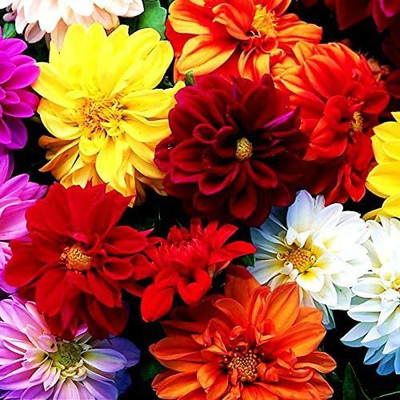CYBEXIS Dahlia Hybrids Dwarf Mix Double Flower Mix Around Red yellow white pink small Seed(50 per packet)
Quick Overview
Product Price Comparison
Dahlia Beauty Mix are dwarf, multi-coloured and long lasting flowers. Dahlia is a genus of bushy, tuberous, herbaceous perennial plants native to Mexico. Dahlias belong to the Aster family along with daisies and sunflowers. The national flower of Mexico, Dahlias today have become one of the most popular competition flowers amongst competitive growers. The Dahlia flower consists of numerous delicate petals that encircle a central yellow core known as the capitulum or floral head. Dahlias can be grown in varying shades of white, yellow, orange, red, pink and purple. Dahlias grow more blooms with 6 to 8 hours of direct sunlight and thrive in rich, well-drained soil. They love the morning sunlight best. The main season is the best time for the Dahlia, reaching full bloom in the mid-summer months and being available from June right through to October. Dahlia's are most commonly used for decorative purposes on cakes, tarts and pastries. Serve alongside cheese or desserts as a garnish. You can use the petals of the Dahlia and add them to grain or green salads to add a pop of color. These bright flowers are easy to grow and ideal as flower beds, borders or background flowers.PLANTING INSTRUCTIONSSoil should be collected in a garden pot mixed with well rotten cow dung or manure.Broadcast the seeds over the soil bed and cover it with a thin layer of sieved sand to allow germination.Maintain a distance of 1.0 feet between the plants.Sprinkle little water and then as per requirement keeping the soil moist.Flowering starts after 45-50 days post transplant which continues for 100-120 days depending on the variety.GROWING REQUIREMENTSPESTSMarigolds are susceptible to damping off (Rhizoctonia solani) and pests like collar rat, Sclerotium rolfsii, Botrytis cinerea, Powdery mildew and cucumber mosaic. The major symptom for these pests is light brown spots on the lower leaves or on early seedlings. To prevent these diseases, ensure proper drainage and ventilation and avoid over watering.SOILSandy loamy soil with pH 5.6 to 6.5 is ideal for its cultivation.SPOTPlace in a spot that receives either full sun or partial sunlight.TEMPERATURE20-25┬░CWATERINGRegular watering keeps the flowers healthy. You can use a water can or a water spray.HOW TO HARVESTFor harvesting marigold, loose flowers are plucked when they attain full size depending upon the variety. Flowers should generally be harvested in the morning hours. Irrigation of soil with water,before plucking, gives better flower quality. Also, plucking of flowers regularly and removal of dried flowers enhances the yield.


